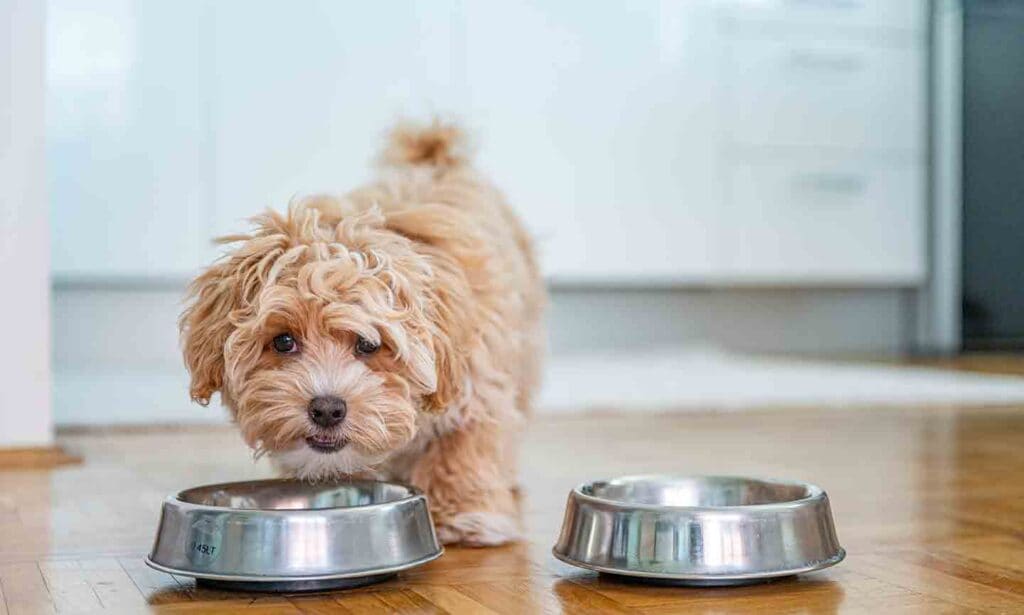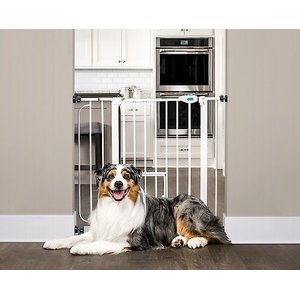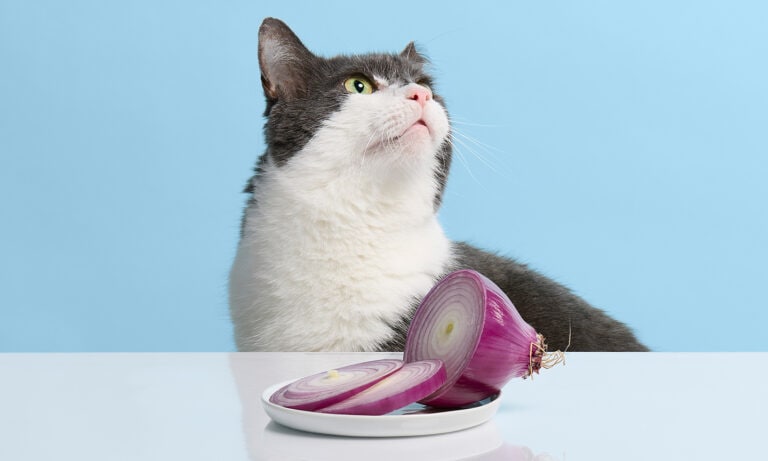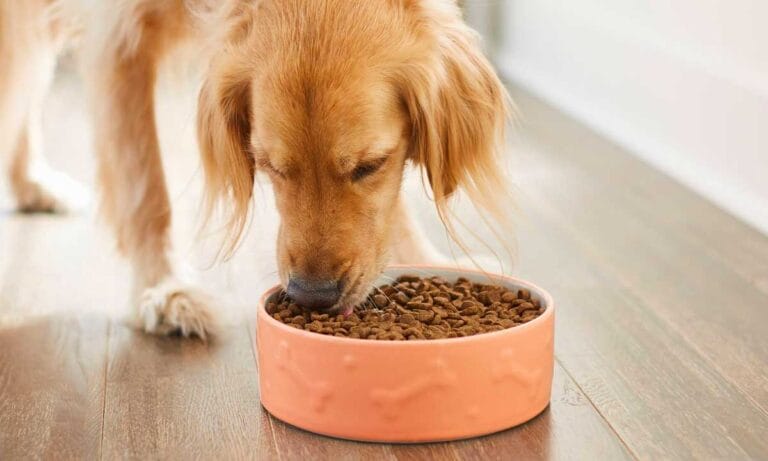People used to think dogs and cats couldn’t live in harmony, but today, plenty of pet parents know that’s not necessarily true. If you have two pets—one cat and one dog —or even multiple cats and dogs, then you know that they can cohabitate (mostly) in peace. But, though they may get along, it is important to keep them somewhat separate, especially when it comes to food. Cats and dogs have different diets, and the truth is, your dog might be more interested in your cat’s food than they should be. We talked to veterinary experts about the risks of dogs eating cat food.
In This Guide
Is Cat Food Bad for Dogs?
Food is food, right? Wrong. Human food does not necessarily equal healthy pet food, and not even pet food works for every type of pet. Just as dogs cannot eat foods like grapes, chocolate, and avocado, cat food is also considered not safe for dogs.
Of course, it’s more complex than just a simple “no.” If your dog eats cat food one or two times, it is not that big of a deal; however, it becomes a cause for concern and significantly affects a dog’s health when they eat cat food over an extended period. Eating cat food can cause myriad health issues for a dog, including pancreatitis, obesity, and gastrointestinal upset, among others.
Dr. Julie Buzby, DVM, who practices in Beaufort, SC, says, “It is not necessarily dangerous for a dog to eat cat food (unless the dog has specific dietary restrictions related to a health problem); however, it’s not ideal. Cat food is formulated for cats, and dog food is formulated for dogs. They are very different animals with different nutritional needs.”
Dogs are omnivores, which means their stomach can tolerate both meat and plant-based food. Cats, on the other hand, are obligate carnivores, so their sensitive stomach can really only handle meat, and they literally require it to survive. This key difference in nutritional needs is why dogs, even an adult dog, really should not eat cat food.
Dogs’ nutritional requirements require a more varied diet, and they need only 10 amino acids, whereas cats need an 11th: taurine. Taurine is crucial for cats’ health in many areas, including vision, heart function, digestion and an overall immunity. Cat food fulfills a cat’s unique nutritional needs, as it contains more meat-based protein, fat content and carbohydrates in addition to taurine.
You may have heard that veterinarians sometimes will prescribe cat food to dogs, particularly in puppies who may need more protein in their diet. However, while that may be true, Dr. Buzby says it’s an outdated method.
“Perhaps decades ago [feeding cat food to puppies] was common, but in 2023, veterinarians have at our fingertips a plethora of excellent dog foods to prescribe or recommend—even if it means ordering online,” Dr. Buzby explains. “Furthermore, we can connect our clients to a board-certified veterinary nutritionist who can custom-formulate a diet (based on a dog’s age/stage, palate preferences and bloodwork), which can be cooked at home.”
If your dog (or your cat) is on a veterinary diet, you should take that into consideration as well while assessing the levity of the situation.
“Veterinary diets are formulated for a specific species—cat or dog, not both—and special health conditions,” Dr. Buzby says, citing low-fat, easily digestible foods for dogs prone to pancreatitis as an example. “Obviously, it is much more concerning for a dog who is on a prescription diet to eat cat food than a healthy dog who has no dietary restrictions,” she says.
It goes both ways, too, according to Dr. Buzby, who says that a cat eating dog food regularly is actually more harmful.
4 Ways Cat Food Is Bad for Dogs
Feeding cat food to your dog is technically OK if you’re in a pinch, but having that nutrient imbalance on a regular basis increases a dog’s risk for several health conditions, including:
- Gastrointestinal upset and digestive issues, including flatulence, diarrhea, constipation, vomiting and upset stomach
- Pancreatitis, inflammation of the pancreas, and liver disease, all of which can arise as a result of a diet too high in protein
- Obesity, as too much protein can also lead to unnecessary weight gain
- Malnourishment, as—because these species have different nutritional needs—feeding cat food to your dog means they are not eating a balanced diet with everything a dog needs and are therefore likely missing nutrients
According to Dr. Buzby, there are three main factors to consider:
- Cat food is higher in protein than dog food.
Cat food is higher in fat than dog food.
Because cat food is a “richer” diet, weight gain can be a problem for dogs eating cat food.
“This technically means that if a dog has no medical reason to avoid high-protein and high-fat content in the diet, and can maintain an appropriate body weight eating cat food, there may be no real red flags,” Dr. Buzby says. “However, this is not the case for the vast majority. Most dogs will gain weight eating cat food, which is more energy-dense than dog food. Being overweight or obese has been linked to earlier onset of health problems like osteoarthritis and even a decreased lifespan in dogs.”
Dr. Buzby also warns that dogs with pre-existing kidney dysfunction or liver disease should stay away from cat food entirely.
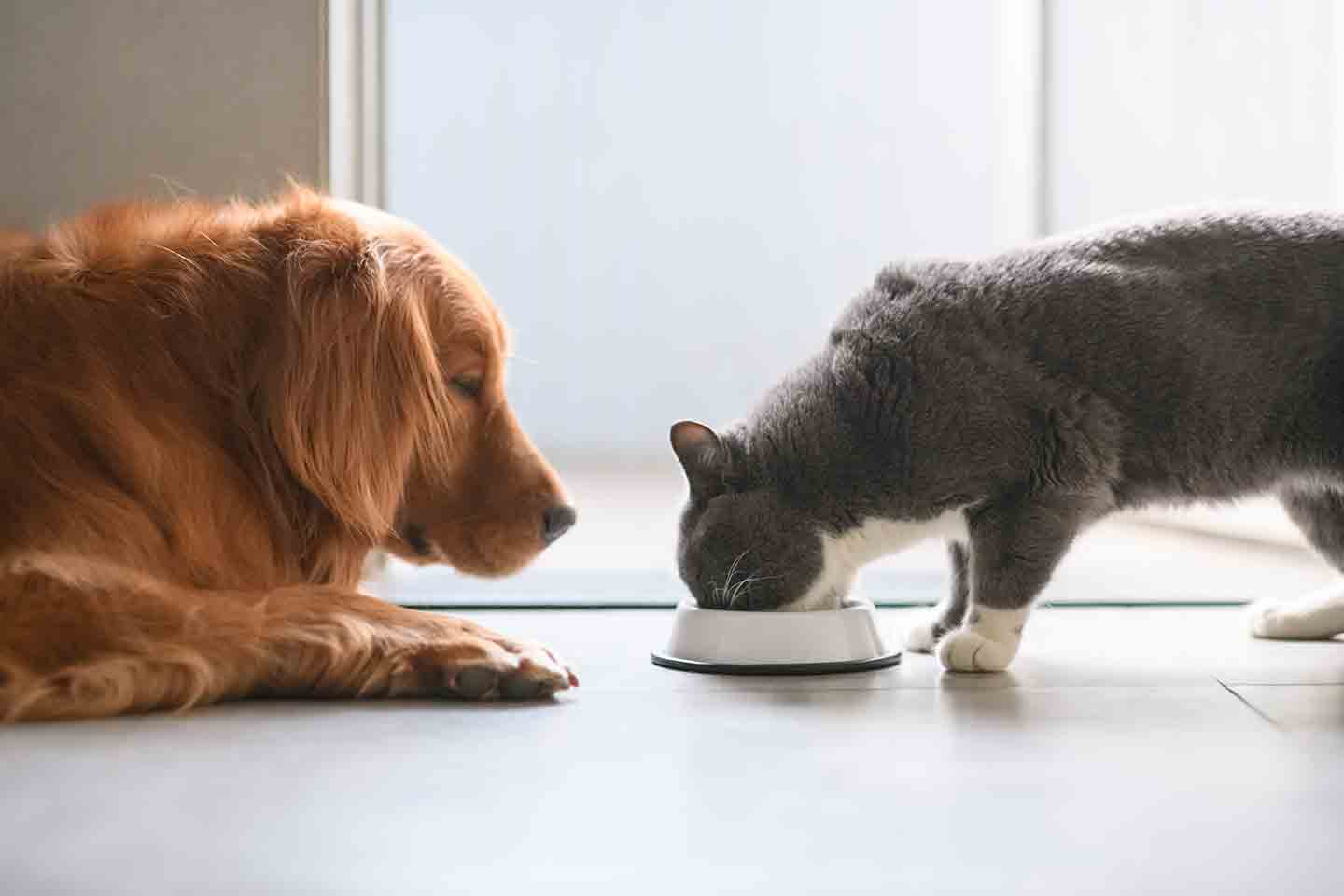
How To Keep Your Dog Away From Your Cat’s Food
“Dog and cat food—a classic tale of forbidden fruit,” Trevor Smith, certified professional dog trainer based in Leander, Texas, and expert with Pupford says. “While the occasional stolen cat kibble won’t land your dog in the pet penalty box, it’s best to keep them on their own menu, for the sake of their health.”
Luckily, there are a few things dog parents can do to help rectify this ongoing problem. To prevent your dog from getting into the cat’s food bowl, try these vet-approved tips:
1Feed your cat someplace high, out of a dog’s reach.
Cats are far better climbers, so positioning their food at the top of their cat tree, or somewhere else up high, puts it out of a dog’s reach. This should immediately solve the problem, but if you’re worried about the food falling or making a mess, there are other options to consider.
2Feed your pets in separate rooms.
By feeding cats and dogs in different areas, you effectively separate the two species so that they can’t access each other’s food. You can also do this with cat treats, if you suspect that your dog has a habit of snatching them. Give your cat their treats in a closed-off room.
3Put up a pet gate.
Putting up a pet gate is another easy way to separate dogs and cats during feeding time. Be sure to get a gate that’s too tall for your dog to jump over.
4Feed your pets at different times.
Another strategy is to feed your cat at a different time than you feed your dog. Consider feeding the cat while the dog is outside or taking a walk. Your dog can come back in when the cat’s done eating, and then, it’s their turn to eat.
5Teach your dog the “leave it” command.
Proper dog training also comes in handy in this situation. If your dog won’t listen to you, it is going to be extremely hard to get them to stop eating cat food without another prevention method or physical barriers. But if you successfully teach your dog the “leave it” command, they will eventually become disciplined enough to avoid the cat food when you say so.
According to Smith, tips for nailing the “leave it” command include establishing strong communication, using positive reinforcement and maintaining consistency. Smith also recommends setting boundaries.
“Train your dog to respect mealtime boundaries with consistency. You can use a ‘place’ or ‘bed’ command to help with this,” Smith says. This method teaches dogs to stay in their bed or at another designated place while mealtime is being served to your cat.
During this training period, positive reinforcement goes a long way.
“Be the Oprah of pet rewards: ‘You get a treat! You get a treat!’” Smith encourages. “Using treats and praise is like giving out gold stars for a job well done.”
6Use a microchip-powered smart feeder.
One of the more technologically advanced ways to keep a dog away from the cat food is a microchip-powered smart feeder, like the Closer Pets MiBowl Microchip Feeder. If both your dog and cat are microchipped, this feeder’s lid stall detection will only offer access to the animal with the “correct” microchip. You can program up to 10 different microchipped pets, so that the feeder knows which one is approaching.
What To Do if Your Dog Eats Cat Food
If your dog has eaten a small amount of cat food, Dr. Buzby says it’s probably OK—at least if it only happens once or twice.
“If your dog has eaten a small amount of cat food and has no health problems, it’s probably no big deal,” she says. “Monitor for digestive upset and call your veterinarian with any concerns.”
However, if your dog is dealing with health issues that put them more at risk, you should consult your veterinarian.
“If your dog does have health issues and is on a prescription diet, it’s worth alerting your veterinarian if this happens, but in most cases, for a one-off incident, monitoring will likely be the treatment of choice, plus making a change in the dog/cat feeding plan to avoid it happening again,” Dr. Buzby adds.
More Dog Feeding Tips
Share:
